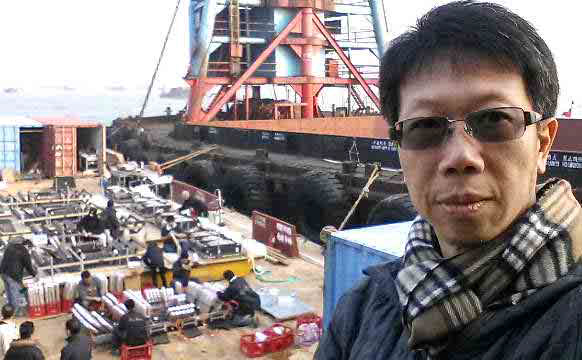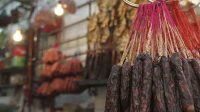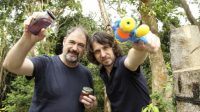On three days of every year – January 1, Lunar New Year and National Day on October 1 – spectacular fireworks light up the Hong Kong skyline, drawing “ooohs” and “aaahs” from the thousands of onlookers.
Watching New Year celebrations on television, from San Francisco to Toronto, it is not uncommon to see footage from Victoria Harbour alongside local celebrations. Hong Kong’s New Year fireworks are world famous, over the top and presented in eye-searing Technicolor, so it was surprising to find mastermind Wilson Mao seated at an empty conference table in an industrial building in Cheung Sha Wan, casually dressed in jeans and jumper.
This place, he assures me, is where the magic happens. A wall along one side of the table is dominated by some of the coolest drawings ever committed to a whiteboard: firework schematics. The far wall accommodates a large-screen television, and all- around there are first-place trophies from fireworks competitions all over the world.
The television, Mao says, is to keep an eye on the competition: “We look at Sydney. We look at London, all the major players, basically ... like Dubai’s last New Year countdown. That was big.”
Mao, a slight, shy man, has good reason to count himself among the big names in fireworks. Pyromagic Multi- media Productions, the company he formed in 1994, is Asia’s largest fireworks production company and Mao has handled every major fireworks display in Hong Kong since 1997.
The company that would give birth to Pyromagic was started by Mao’s grandfather in 1953 as a general mercantile company, trading Chinese goods across Southeast Asia.
Fireworks were just one of many commodities he traded. It was Mao’s father who began to shift the focus to fireworks, selling them in Hong Kong and Macau before the riots in 1966 resulted in a sweeping ban.
Forced to look elsewhere, he took advantage of cooling tensions between the US and China, and began exporting fireworks to America – the US remains one of Pyromagic’s most important customers.
He also dabbled in pyrotechnic displays in Southeast Asia. In the 1980s, Mao’s father partnered with a US fireworks company to put on his first Lunar New Year display in Victoria Harbour. The rest is history.
When he was a small child, helping his father set up displays across Southeast Asia, Mao got his first taste of the life of a fireworks designer. It might seem like a young boy’s dream, growing up in the fireworks business and helping your dad blow things up.
But Mao laughs at the idea: “I wasn’t that destructive. I really like to play with fireworks with some kind of design, you know.
“I don’t like something to shock your nerves. That’s not an art at all; it’s destruction to me. It hurts.” He gestures towards pictures of fireworks covering the walls. “I like colour. I like music. I like lines, tails, all of that.”
His love of design stayed with him through university in California, where he majored in engineering and design.
“Everything about design is something I like. Fireworks are a synchronisation of music, timing, colour, layering, and angles. It’s pretty much architecture.
“It’s like an engineering drawing in colour and light,” he says. Mao is also a great lover of music, and thinks that is the foundation of all the best fireworks displays: “The music comes first.” After selecting the perfect
score – “music that is slow, then is fast, music that suddenly jumps up” – Mao and his four designers gather in the conference room listening to the music turned up loud on overhead speakers and brainstorm ideas, shouting out fireworks effects and transitions.
There are many to choose from – the effects file at Pyromagic contains more than 50,000.
Once an aesthetic for the display has been determined, the team creates a spreadsheet which acts as a schedule of the different fireworks to be used.
“The last Western New Year alone was only eight minutes and was already 6,000 lines,” he says. Then, computer-shy Mao passes the spreadsheet on to his technology team, a group of “kids from the 1990s”, who use modelling software to turn the spreadsheets into computer animations.
These animations are the closest thing fireworks technicians get to a rehearsal. For obvious reasons – among them safety, expense, and spatial limitations – actual rehearsals are out of the question.
The fireworks displays that Pyromagic deals with are massive. The January 1 show this year was the biggest in the company’s history.
“We had five barges, 20 pontoons, seven rooftops. We also had an LED display, a big one, 50 metres high by 50 metres wide. It was crazy and scary when you look at the size of the structure.”
A display of that scale can take 10 days to set up and dismantle.
For Lunar New Year, Mao is planning something a bit smaller. It's only a four-barge display, but what it lacks in size will be made up for in the cutting-edge effects.
A gimmick in which the word "WIN" will be spelled out in lights has been publicised, but there are surprises in store, including fireworks in the shape of horseshoes, horse tails, and a pair of lips which pay homage to sponsors, Sasa. The display will cost nearly HK$8 million.
Mao says he loves his job, but as the displays grow larger and larger, the stresses and risks are starting to weigh on him. “After so many years, I just don’t like to risk so much,” he says.
“We deal with explosives, and if you don’t treat them well, if you don’t respect fireworks, they will kill you.”
Ever the engineer, Mao takes a breath before starting again. “But they are actually very obedient, you know? You hit the button, they fire. It’s physics. But you have to pay respect.”
Although Pyromagic has never had a serious accident, it is obvious that the dangers of fireworks are always on Mao’s mind. He has an 11-year-old son, and when asked if he would want him to go into the business, Mao’s unable to answer.
But he acknowledges that if his son does, it will be a different world from the one in which Mao learned the craft. Technology is changing the game.
“By the time my kid is grown up, fireworks will not be the only multimedia element. We’re actually a multimedia company, not only fireworks, we have a lighting team, sound team, laser team, fireworks team, and LEDs all working together.
“So he has to work on the multimedia side and not be too focused on fireworks like his father,” he says.
“I’m too focused on fireworks, because that’s how I was brought up.”



